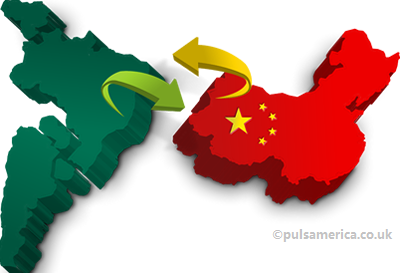 Intro:
Intro:
China’s investment in Latin America has continued to grow in recent years. China has become the Latin America’s third biggest source of foreign investment. According to the latest statistics from China’s Ministry of Commerce, in 2013, Latin America was the second largest recipient of China’s foreign direct investment after Asia. In 2013 the investment increased over 130% on the amount in 2012. Countries such as Ecuador Peru and Brazil are the main investment destinations. Much of China’s investment in Latin America has been directed at the extractive industries, with a number of large mining deals signed in the last year. Mining projects often involve huge amounts of capital, and foreign investments in the extractive industries often raise concerns regarding national resource security. Driven by China’s growing demand for resources, investment in mining projects in Latin America has increased rapidly, which has drawn the world’s attention to this issue. Chinese enterprises are now confronted with various new challenges and are having to adapt to situations and problems that may not be familiar to them. Chinese investors continue to adapt to the often complex international investment environment, but at the same time, negative reports continue to emerge regarding the implementation of overseas investments. Chinese enterprises should therefore reflect upon the impact of their overseas investments and operations, and ensure that lessons are learned from cases that have impacted on local communities and the environment. In such cases, the root causes of these problems must be identified and appropriate solutions found.
 Alert:
Alert:
- Official Statistics Release: China 2013 outbound investment hits record high
- MOFCOM Releases New 《Overseas Investment Management Measures》 which will be effective on October 6, 2014
- Chinese mining enterprise boom a new wave of infrastructure funding and raise concern about social and environmental impact
- $7 billion, MMG brought the largest copper mine: Las Bambas from Glencore
 Sharing:
Sharing:
- Analytical Report:《Perspective Asia: Copper, Coal, and Conflicts——Resource and Resource Extraction in Asia》(Heinrich Boell Foundation)
- Analytical Report :《Managing Environmental Impact- International Experience and Lessons in Risk Management for Overseas Investments》(WRI)
- Official Statistics: 《2013 Statistical Bulletin of China’s Outward Foreign Direct Investment》(China Statistics Press)
- Policy Document: New《Overseas Investment Management Measures》(MOFCOM)
- Conference Review:The 8th China-Latin America Business Summit|Sep 12-13|Changsha Hunan
 View
View
HSBC Global Connections 《South-South: China invests in Latin America》:Chinese firms are exploring new markets, acquiring advanced technology and securing much-needed raw materials. The result has been a spectacular rise in China’s outbound direct investment and Latin America is the largest recipient outside Asia. The booming trade relationship between LatAm and China is part of the commercial connections between Asian nations and Southern Hemisphere countries dubbed ‘South-South’ trade. But it has moved beyond simple exports to Chinese bank lending and direct investment through acquisitions and start-ups.
Paulina Garzon Ecuador’s Centre for Economic and Social Rights (CDES) :The GCD sets a very high bar, but put it into practice is another matter. Two things that Chinese banks and many countries in Latin America have in common are that their environmental regulations are OK, but the implementation and supervision systems are very weak.
Huang Hongxiang, initiator of China-South Dialogue:Through interviewing local government officials, industry leaders and academics, I have come to find that Chinese enterprises have encountered numerous problems such as lack of the capability for intercultural communication and integrating with the local society.But if (Minmetals can) learn from Shougang and Chinalco's experiences in Peru, overcome certain weakness of state-owned enterprises, recruit proper international talents, it might become an interesting case for Chinese mining companies' development overseas,"
中铝秘鲁特罗莫克铜矿的曲折进程
中国铝业公司(以下简称中铝)是2001年建立的央企,主要从事矿产资源开发、有色金属冶炼加工、相关贸易及工程技术服务等。目前跻身世界500强企业行列,是全球铝业和铜业综合实力居于前列的大公司。近年来,中铝应对国际金融危机冲击,部分区域重点转向海外资源富集地,由本土国有企业向跨国公司转型。中铝现有所属企业66家,业务遍布全球20多个国家和地区。
秘鲁特罗莫克铜矿是中铝最早在海外投资的项目之一,自2008年收购以来,如许多中国海外投资项目一样,经历了种种挑战。我们在这里综合多篇报道,跟踪项目的曲折进程,希望增加读者对海外投资问题的理解,并对这些经验教训有所借鉴。
项目背景
位于秘鲁中部莫罗科查矿区的特罗莫克铜矿,其资源储量包含约730万吨铜、29万吨钼和1.05万吨银,是当地规模最大的矿业项目,也是截至2014年4月中国公司在海外投资规模最大的矿山项目。
2007年中铝完成了对加拿大秘鲁铜业公司的全部股权收购,从而获得了秘鲁特罗莫克铜矿的开发权,并于2008年5月完成收购,项目总资本支出约35亿美元。其中8亿多美元用于购买采矿权,15亿美元用于改善社区关系和环境保护。经过五年多的前期建设,特罗莫克铜矿终于在2013年12月正式投产。
前期建设的投入
中铝在未排放一滴矿业污水的情况下,先期投入了5000多万美元,用两年的时间建成了一座现代化的污水处理厂,解决了困扰当地居民70多年的水源不洁问题。而中铝为当地保护水源的工作还在继续,据秘鲁《商报》近日报道,中铝秘鲁公司将联合秘鲁企业修建水库和污水处理厂,为铜矿所在的胡宁大区的7个社区家庭拓宽供水管道、并为当地居民提供有关珍惜水利资源的培训课程。
中铝为了取得当地居民对铜矿的支持,在破旧不堪的小镇10公里远处完全新建了一座城镇。新城2012年建成,斥资2.17亿美元,另外还有5000万美元用于搬迁。中铝是南美第一家通过建设新城来解决矿区原住民问题的公司,其表现获得了不少认可。秘鲁中国研究中心主任马丁内斯认为,中铝在秘鲁所做的工作让他们看到一个新的中国形象,中国不仅遵照国际规范来做事,而且还尝试着本土化。秘鲁方面的中铝特罗莫克铜矿项目负责人Gerald Wolfe表示:“城镇的修建动用了全部所需专家,我们希望有一个好的结果。”
污染风波
2014年3月28日,特罗莫克铜矿投产刚刚四个月,秘鲁环境部所属环境评估与监管局(OEFA)通知中铝秘鲁特罗莫克铜矿项目立即停止生产。该局监查处处长德里亚·莫拉莱斯称, 检查过程中,监管局人员发现中铝没有按规定安装污水收集及处理系统。
在中铝铜矿的作业区两个废料库各通过一条水道分别通往两个小湖。经过检查及收集各种数据资料后得出结论,在该公司两个废料库的废料中发现了明显的、高浓度的酸液,废水的PH值达分别达到4.8和3.25,而这些污水被排放到附近的两个湖中,其中一个湖被当地列为野生动物保护区。
3月28日起,中铝秘鲁铜矿的矿石开采现已全部停止,其选矿厂及其他配套生产活动也被要求相应停止。4月10日,中铝秘鲁铜矿完成了对水管理系统的优化和改善工作。随后,秘鲁环境评估与征税局对有关情况进行了现场检查,并于4月11日通过了新的决议,解除所有就排水问题对特罗莫克铜矿进行的预防性措施。
据了解,特罗莫克铜矿在收到上述决议后,已经恢复了全部正常的生产活动,继续按照2014年的生产经营计划展开工作,并有望于第三季度达到全额产能。届时,这个拥有1200万吨铜当量金属资源的全球特大型铜矿,将每年向中国国内输送22万吨铜精矿,约占中国国内当前自有产量的18%,会极大地缓解我国铜精矿供给短缺、对外依存度过高的发展瓶颈。
中铝公司认为,虽然这次历时14天的采矿部分停产活动并未对特罗莫克铜矿产生重大影响,也未造成对于秘鲁环境的实质性损害,但这仍然足以引起中铝公司的高度关注和总结思考。
资料显示,中铝秘鲁特罗莫克铜矿作为秘鲁国内近年来建成投产的最大矿业项目和中国在秘鲁当前最大的投资项目,自中铝公司2008年获得其开发权以来,受到了两国政府、居民和全球社会各界的广泛关注,该项目先后获得了包括项目环评报告等建设所需的300多个各类许可证。中铝表示:“每一个细小的疏忽和不足,都应当以最严谨的态度和科学的方法快速解决,并成为中铝公司继续完善自身发展质量与水平的重要机会。”本着对生态环境和各方利益负责任的积极态度,中铝公司将进一步要求各企业和项目严格遵守所在地法律法规和风俗习惯,并欢迎社会各界的监督和帮助,更加公开透明地向各界进行相关的信息公开,使宝贵的资源能源成为造福人类的共同财富。
编者短评: 中铝公司在该项目中的环境和社区改善投入确实可观,但一处疏忽就导致了停产整顿和其他负面的误解。可见中国企业在海外投资过程中,不仅需要和当地社区保持良好关系,还应该在生产过程中坚持不懈严谨遵守安全生产和污染处理的标准,切实履行企业社会责任,建立长期信任合作关系。
信息来源:




